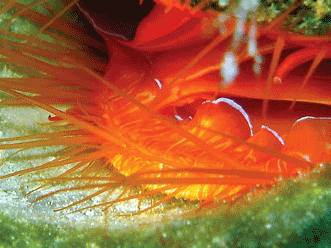
Disco (clam) is (not) dead
The ocean is filled with millions of wondrous creatures and even more that have yet to be discovered. The grandest of animals have always taken center stage, though, like mammoth blue whales, deadly box jellyfish or even giant squid. Therefore, it takes a special kind of person to home in on the humble, focus on the details and ask questions that many overlook.
“I’ve dived with humpback whales and great white sharks,” said Lindsey Dougherty, a dive instructor and graduate student at the University of California, Berkeley. “But when I saw the disco clam, I was enamored.”
The reason? The rather unassuming little mollusk flashes light like a disco ball.
“I said then, ‘I’m going to do a Ph.D. on the disco clam,’ ” Dougherty said.
And she did: After first encountering the 2-in. creature in the waters of Wakatobi, Indonesia, she has held true to that vow and discovered some remarkable things in her postgraduate studies.
“No one seemed to know either how the flashing worked, or why it was flashing in the first place,” she said. “We seem to know so little about the ocean, and the fact that no one had figured out why these little clams were flashing seemed mind-boggling.”

Photo courtesy of Lindsey Dougherty.
Taking up the quest herself, Dougherty soon discovered that the disco clam’s flashing was not, as most people assumed, a form of bioluminescent glowing. She instead found the answer in reflection. The edge of the clam’s mantle lip is highly reflective on one side. When it’s furled and unfurled – typically twice a second – the millimeter-wide mirror is revealed, reflecting ambient light from the sky like a disco ball.
“The most obvious indicator that bioluminescence wasn’t the culprit for this unique show is that none of my dive buddies recounted seeing the disco clam flash at night, when bioluminescence is prevalent,” Dougherty said. “The flashing is extremely vivid during the day, when there is a fair amount of ambient light.”
The inside of the clam’s lip is packed with tiny spheres of silica only 340 nm in diameter and can reflect blue light, which penetrates deeper into seawater than red light. There are no silica nanospheres on the outside of the lip, causing a continuous, flowing light show when the clam quickly ripples its lip back and forth.
Dougherty used high-speed video, transmission electron microscopy, spectrometry, energy-dispersive x-ray spectroscopy and computer modeling to study the detailed internal structure of the clam’s lip margin.
“Aside from the myriad of technological and optical innovations that understanding these nanostructures helps produce, I’m also just fascinated by how complex a seemingly simple visual display can be,” Dougherty said. “The root of the question is why these disco clams are flashing, which I’m currently working on, but it’s also interesting to think about the intricate development and physiological control that go into producing the display.”
Published: September 2014